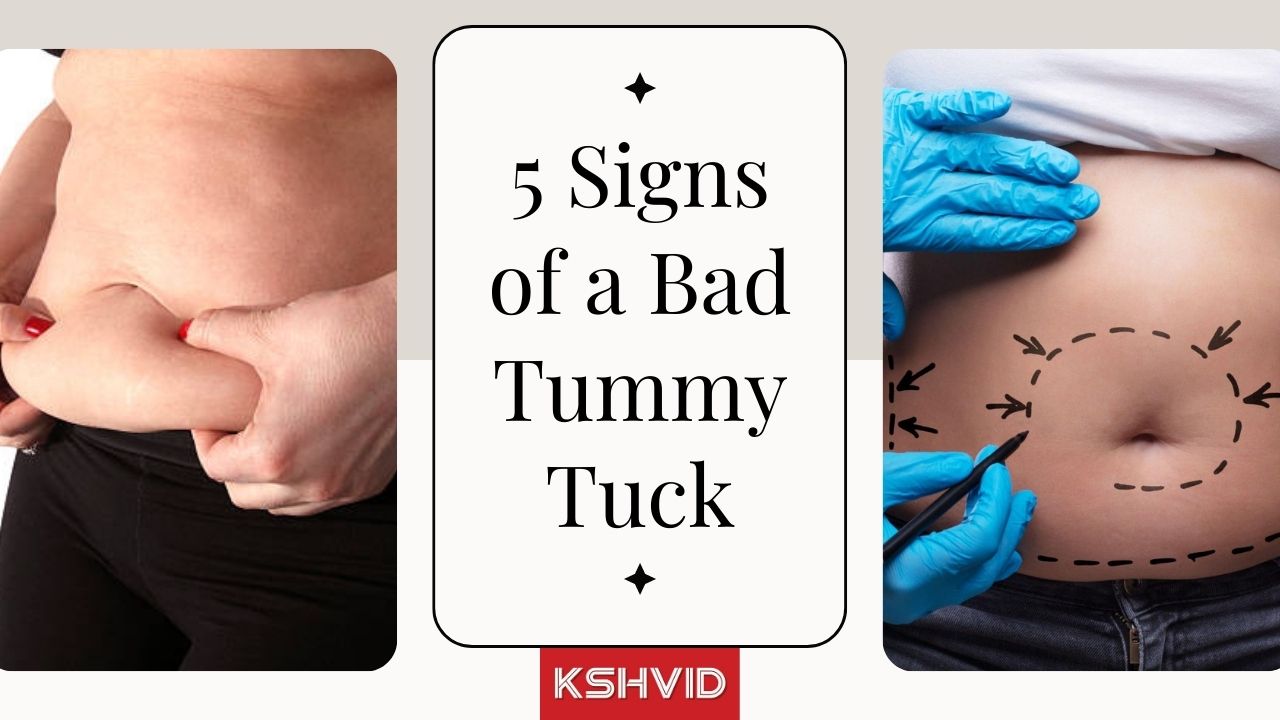A tummy tuck, also known as abdominoplasty, is a cosmetic surgery performed on the abdomen region. The goal is to achieve an improved look at your stomach area. Unfortunately, there are signs of a bad tummy tuck, such as a pulling feeling after a tummy tuck.
The surgery for a tummy tuck is carried out for various reasons, most commonly seen following significant weight loss, baby birth, or a c-section.
In this technique, the abdominal muscles and tissues are tightened to get a smoother, tighter, and flatter stomach. If you feel like why your stomach is flabby after a tummy tuck, you must look for the signs. If you are thinking of getting a tummy tuck, keep reading this blog to know the apparent signs of a bad tummy tuck to avoid it.
Read: Extended Tummy Tuck: myths, procedure and benefits
5 Signs of a Bad Tummy Tuck Gone Wrong
When the surgery is performed, and you are in the recovery stage, the initial days are tough, but when you regain your strength and gentle movement, you can check if the surgery was a hit over time. Although no plastic surgery can guarantee the results, you can expect the best.
Here, we enlist a few signs of a bad tummy tuck. It might help you regarding getting the best treatment and prevent some complications.
Read: 5 Signs of a Bad Tummy Tuck Gone Wrong
1: Unhappy position of your navel:
In most cases, a surgeon performs the navel repositioning following the tummy tuck procedure. If this is done correctly, it can positively impact the overall appearance of your abdomen.
Here are some issues that can make you feel to reposition your navel such as:
- Positioned too high.
- Positioned too low.
- Too shallow or misshapen.
- Lopsided.
If you notice any signs in your navel positioning, consult your surgeon and share your concerns. Fortunately, the navel revision can be easily done without secondary abdominoplasty.
2: You are unhappy with the abdomen shape:
Abdomen shape is a major factor that helps you conclude if you had a great surgery and the results are fine. A tummy tuck should give you smoother, slimmer, and more accurate abdominal contours.
The abdomen’s uneven and unbalanced shape typically occurs due to an imbalance in post-surgery skin tension. In such cases, you may need to revise the surgery to get it done and corrected.
Rush to your surgeon and share your concerns about the expected abdominal contours and the difference in results.
3: Scar is too high:
One of the botched signs of a bad tummy tuck includes a high scar. Ideally, the tummy tuck incisions are in the lower region, can be easily hidden with underwear.
Surgeons know the best tricks that can minimize scarring. But, a non-experienced person will leave you with an incision that is too high and very obvious.
So, ensure the scarring is low and can be covered easily post-surgery. If you feel unsatisfied with the placement or the appearance of the scar, address the issue and look at what can be done to rectify the issue.
4: Irregular contours:
As mentioned earlier, abdominoplasty helps you achieve the perfect flatter and tighter stomach. In addition, the surgical procedure deals with loose skin and sagging muscles following birth, aging, or significant weight loss.
If you feel an imbalance and irregular contour on the sides of your abdomen, you can consider a tummy tuck revision.
There can be several reasons that can result in the symptoms of muscle separation after tummy tuck which causes not enough tightening of muscles.
Likewise, there can be various signs of an uneven waist after tummy tuck that also shows that your tummy tuck went wrong.
5: Nerve damage:
Another sign of tummy tuck gone bad problems is nerve damage. Lateral femoral injury is a known complication of abdominoplasty.
Nerve damage concerns cosmetic abdominoplasty and is a major sign of surgery failure. It causes the nerves to be traumatized for weeks and cause numbness in the area for several weeks to months. Then, it can be treated, and nerves can be connected again in the damaged section.
Read: Cryoslimming: Why It’s The Latest Trend In Weight Loss
How to Avoid a Bad Tummy Tuck?
A bad tummy tuck can happen to anyone, but fortunately, you can recover it after some time. There are two major steps involved in repositioning the abdomen. The first step is to recover fully by following your surgeon’s orders and instructions.
Your body needs time to recover from the surgery before another operate. So, take adequate rest and recover soon. Do not rush the process. A good recovery process will reduce the risk of tummy tuck complications years later.
The next step is to choose a qualified and reputable surgeon or consult the previous one to resolve the issues.
Share all your concerns about the abdomen shape, scar position, nerve damage, and other problems that need to be fixed. Also, follow your surgeon’s instructions to avoid gastrointestinal problems after tummy tuck.
Read: How Do You Know If It’s Fat Or Loose Skin?
What to Do if you Have Had a Bad Tummy Tuck?
The first thing to do after a bad tummy tuck is to contact a trusted surgeon and share your concerns.
A well- experienced and qualified surgeon can help you with your issues and can resolve them such as high scar and position.
Moreover, learn more about tummy tuck recovery issues and tummy tuck gone bad problems.
Complete your part of the research about the issue and the solution. Make sure you spend enough time in the surgeon hunt before starting the procedure.
Read the online reviews and get in touch with the people who have already undergone the treatment. Learn from their experience and try to avoid the mistakes.
Read: 3 Home Remedies to Lose Belly Fat Overnight with Vaseline
Final words:
Abdominoplasty, like other cosmetic procedures, is safe, but it can go wrong for several reasons. Tummy tuck 20 years later can also become problematic, so make sure you choose a qualified surgeon. Look for the signs of a tummy tuck gone bad problems and resolve them in time.
Read: 5 Ways to Keep C-section Incision Dry When Overweight










